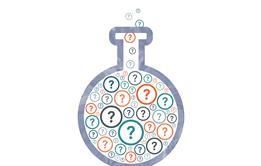Let’s hope your students aren’t as lazy as the one in this experiment scenario
A student has contacted the students for help with purification of his sample of benzoic acid (contaminated with benzyl alcohol and Cr3+ residues). Recrystallisation of the sample is followed by TLC analysis to prove its purity.
Pre-Lab questions
(Remember to give full references for any information beyond A-level that you find out)
- Acidified potassium dichromate is a common oxidising agent for alcohols. In the process of the reaction Cr2 O72– is reduced to Cr3+. Write two half equations for the oxidation of ethanol to ethanoic acid using acidified potassium dichromate [HINT: In the oxidation process, the carbon bonded to the oxygen is the atom undergoing oxidation (oxidation state –1 → +3)].
Combine the two half equations to give the full redox equation for the reaction.
- For each of the alcohols below, name the alcohol and draw and name the product obtained from the oxidation of the alcohol after refluxing in excess acidified potassium dichromate.

- Impure solids can be purified by recrystallisation. Outline the steps involved in the purification of a solid by recrystallisation
- Generally, organic compounds are insoluble in polar solvents such as water and ethanol. However carboxylic acids are an exception, with short chain carboxylic acids being totally miscible with both water and ethanol. Use your understanding of the interactions involved to explain the data below (taken from http://www.auburn.edu/~deruija/pda1_acids1.pdf)
| RCOOH; R= | Solubility in water/ g per 100 cm3 | Solubility in ethanol/ g per 100 cm3 |
|---|---|---|
| H- | soluble | soluble |
| CH3- | soluble | soluble |
| CH3CH2- | soluble | soluble |
| CH3CH2CH2- | soluble | soluble |
| CH3CH2CH2CH2- | 3.7 | soluble |
| CH3CH2CH2CH2CH2- | 1.0 | soluble |
| C6H5- | 0.34 | soluble |
| CH3(CH2)8- | 0.015 | soluble |
| CH3(CH2)10- | Insoluble | 100 |
| CH3(CH2)12- | Insoluble | soluble |
| CH3(CH2)16- | Insoluble | 5.0 |
Equipment
Chemicals
- Sample of L.A. ZYUDENT’S PRODUCT MIXTURE in a conical flask made up of;
- Benzyl alcohol (phenylmethanol) [Harmful (by inhalation and if swallowed)] (0.5 g)
- Benzoic acid [Harmful (if swallowed) and irritating to eyes] (1.5 g)
- Benzyl alcohol (phenylmethanol) [Harmful – by inhalation and if swallowed]
- Benzoic acid [Harmful – if swallowed and irritating to eyes]
- Hexane [Highly flammable, Harmful, Dangerous for the environment]
- Ethyl acetate (ethyl ethanoate) [Highly flammable, Irritant]
- Ethanol [Highly flammable]
- Hexane [Highly flammable, Harmful, Dangerous for the environment]
- Ethyl acetate (ethyl ethanoate) [Highly flammable, Irritant]
Apparatus
- Bunsen burner, tripod, gauze and heatproof mat
- 1 × 100 cm3 conical flask
- Equipment for hot filtration (1 × pre-warmed conical flask and filter funnel with small plug of mineral wool)
- Ice bath
- Büchner flask, Büchner funnel, filter paper and suction method
- Deionised water
- TLC equipment;
- TLC jar
- TLC plate × 2 (silica gel coated with fluorescent indicator; carrier sheet either polyester or aluminium. These can be cut to an appropriate size)
- 3 × small beakers or specimen tubes for making up the TLC samples
- TLC spotters or capilliary tubes
- Tweezers
- Access to UV lamp [WARNING! Avoid looking directly at the light]
- Access to KMnO4 * dip and heat gun / hot plate
- a few anti-bumping granules
- 1 drop of green food colouring
- Small conical flasks
- Access to solvents;
- water
- A safe heat source – either a hot plate or a hot water bath for heating the flammable solvents
*The potassium permanganate (KMnO4) dip is made by dissolving 3 g of KMnO4 [Oxidising, Harmful, Dangerous for the environment], 20 g of K2CO3 [Irritant] and 5 cm3 of a 5% aqueous solution of NaOH [Corrosive] in 300 cm3 of water and stirring for 10 minutes. Once made, it can be stored in a brown glass jar for repeated use.
Health, safety and technical notes
- Read our standard health and safety guidance.
- Benzyl alcohol (phenylmethanol) [Harmful (by inhalation and if swallowed)] (0.5 g) See CLEAPSS Hazcard HC044a
- Benzoic acid [Harmful (if swallowed) and irritating to eyes] (1.5 g) See CLEAPSS Hazcard HC013a
- Bexane [Highly flammable, Harmful, Dangerous for the environment]
- Ethyl acetate (ethyl ethanoate) [Highly flammable, Irritant] See CLEAPSS Hazcard HC045a
- Ethanol [Highly flammable] See CLEAPSS Hazcard HC040a
- Hexane [Highly flammable, Harmful, Dangerous for the environment] See CLEAPSS Hazcard HC045a
- Ethyl acetate (ethyl ethanoate) [Highly flammable, Irritant] See CLEAPSS Hazcard HC043a
- If the students are working at different rates through the practical, it is important that flammable solvents such as the chromatography solvent are not being used at the same time as a Bunsen burner is being used to recrystallise the sample in water. One solution would be for the students to complete the TLC analysis of the samples in a fume cupboard.
- It is the responsibility of the teacher to manage the laboratory such that all risks are minimised.
Put this in context
Watch the video to find out how bioanalytical scientist, Claire tests new medicines in various stages of drug development to ensure they are robust and reliable before being released onto the consumer market.
Extension discussion points
- What is the chemistry behind the potassium permanganate TLC stain?
- Why is it important to dissolve the sample in the minimum quantity of hot solvent?
Downloads
Coursework conundrum student sheet
PDF, Size 0.23 mbCoursework conundrum teacher & tech sheet
PDF, Size 0.23 mb
Additional information
This resource was developed by Catherine Smith, RSC School Teacher Fellow at the University of Leicester 2011 – 2012, produced as part of the National HE STEM Programme

Problem based practical activities

Discover how chemistry can relate to real world problems, so students can put their science knowledge into context.
- 1
- 2
- 3
- 4
- 5
 Currently
reading
Currently
reading
Coursework conundrum
- 7
- 8
- 9
- 10
- 11











































No comments yet